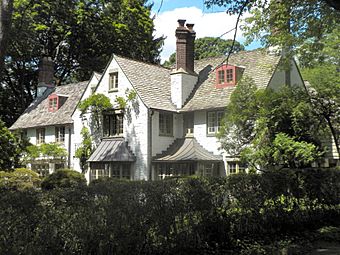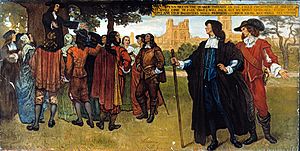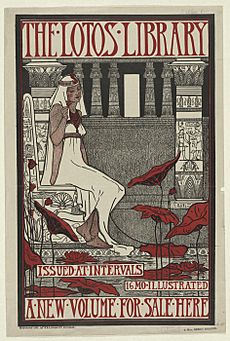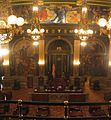Violet Oakley facts for kids
Quick facts for kids
Violet Oakley
|
|
|---|---|
 |
|
| Born | June 10, 1874 Bergen Heights, New Jersey, U.S.
|
| Died | February 25, 1961 (aged 86) Philadelphia, Pennsylvania, U.S.
|
| Resting place | Green-Wood Cemetery |
| Known for | Painting, murals, stained glass |
|
Notable work
|
Pennsylvania State Capital murals |
| Movement | Pre-Raphaelite influence |
Violet Oakley (born June 10, 1874 – died February 25, 1961) was an American artist. She was the first American woman to get a public job to paint a mural. In the early 1900s, she was famous for being a pioneer in mural painting. This field was usually only for men. Oakley was excellent at creating murals and stained glass designs. Her art often showed themes from history and literature, using a style inspired by the Renaissance.
Contents
Violet Oakley: A Trailblazing Artist
Early Life and Art Training
Violet Oakley was born in Bergen Heights, Jersey City, New Jersey. She came from a family of artists. Both of her grandfathers were members of the National Academy of Design. In 1892, she started studying art in New York City. She then studied in England and France.
When she returned to the United States in 1896, she joined Howard Pyle's famous illustration class. Pyle was a very important teacher. Oakley quickly became a popular artist for magazines like The Century Magazine and Collier's. Her art style, especially her illustrations and stained glass, was inspired by the English Pre-Raphaelites.
Quaker Beliefs and Public Art
Oakley's ideas were greatly shaped by the Quaker leader William Penn. She showed his beliefs in her murals at the Pennsylvania State Capitol. She strongly believed in Quaker ideas like pacifism (peace, not war), equality for all people, fairness in society, and international cooperation.
After World War I, the United States decided not to join the League of Nations. This was an international group formed to prevent future wars. Oakley went to Geneva, Switzerland, and spent three years drawing portraits of the League's leaders. She later published these drawings in a book called "Law Triumphant." After World War II, she also supported nuclear disarmament, which means getting rid of nuclear weapons.
Personal Life and Artistic Community
Oakley was raised in the Episcopal church. However, in 1903, she became a devoted student of Christian Science. This happened after she was healed from asthma while studying in Florence, Italy.
Around 1897, Oakley and her sister Hester shared an art studio in Philadelphia. Oakley and her friends, artists Elizabeth Shippen Green and Jessie Willcox Smith, were all students of Howard Pyle. Pyle called them the "Red Rose Girls." This nickname came from the Red Rose Inn in Villanova, Pennsylvania, where they lived together from 1899 to 1901.
Later, these three artists, along with Henrietta Cozens, lived in a home in Philadelphia. They named it Cogslea, using parts of their last names (Cozens, Oakley, Green, Smith). In 1996, Oakley was honored by being chosen for the Society of Illustrators Hall of Fame. Her home and studio, the Violet Oakley Studio, is now a historic place.
Oakley was also a member of The Plastic Club in Philadelphia. This group was formed by women artists to support each other and sell their artwork. Many of its founders were students of Howard Pyle.
Violet Oakley is buried in Green-Wood Cemetery. Her close companion, Edith Emerson, was also a painter and had been Oakley's student. Edith Emerson later created a foundation to remember Oakley's life and art.
The "New Woman" and Women Artists
In the 1800s, more educational chances opened up for women. This allowed women artists to become part of professional art groups. Even though art by women was sometimes seen as less important, women artists worked hard to promote their work. They became part of the idea of the "New Woman." This term described educated, modern, and freer women.
Artists played a key role in showing what the New Woman was like. They drew pictures of her and lived lives that showed this new type of woman. In the late 1800s and early 1900s, many magazine readers were women. Publishers hired women artists to create illustrations that showed the world from a woman's point of view. Other successful women illustrators included Jennie Augusta Brownscombe and Rose O'Neill.
Major Artworks and Commissions
|
Violet Oakley Studio
|
|
 |
|
| Location | 627 St. George's Rd. Philadelphia, Pennsylvania |
|---|---|
| Built | 1902–05 |
| Architect | Day & Klauder |
| NRHP reference No. | 77001188 |
| Significant dates | |
| Added to NRHP | September 13, 1977 |
Violet Oakley's teacher, Howard Pyle, helped her get her first big job. This was to create illustrations for a book called Evangeline in 1897. After that, she received many more art jobs.
Oakley painted 43 murals in the Pennsylvania State Capitol Building in Harrisburg. These murals are in the Governor's Grand Reception Room, the Senate, and the Supreme Court. She was first hired in 1902 to paint the murals in the Governor's Reception Room. She called this series "The Founding of the State of Liberty Spiritual."
For these murals, Oakley researched a lot about William Penn and the founding of Pennsylvania. She even traveled to England. The murals were shown in the new Capitol Building in 1906. Later, in 1911, she was asked to create murals for the Senate and Supreme Court Chambers. This project took her 16 years to complete.
Other important works by Oakley include:
- Two murals and stained glass for All Angels Church in New York City (1900).
- Murals for the Cuyahoga County Courthouse in Cleveland, Ohio. This was her only big mural job outside Pennsylvania.
- Eighteen mural panels and a stained glass dome for the Charlton Yarnell House in Philadelphia (1910).
- Great Women of the Bible murals for the First Presbyterian Church in Germantown (1945–1949).
- Three murals, David and Goliath, Christ Among the Doctors, and The Young Solomon, in the library at Springside Chestnut Hill Academy.
- Life of Moses, an altar piece for the Samuel S. Fleisher Art Memorial in Philadelphia (1927).
Exhibitions and Recognition
Violet Oakley received many awards during her life. In 1904, she won a gold medal for her illustrations and a silver medal for her murals at the Saint Louis International Exposition. In 1905, she was the first woman to receive the Gold Medal of Honor from the Pennsylvania Academy of the Fine Arts.
In 1915, she won the Medal of Honor for painting at the Panama–Pacific International Exposition. This was for her 1912 portrait of the poet Florence Van Leer Earle Coates.
Her artwork has been shown in many exhibits:
- In 1950, Lehigh University held an exhibit of her work.
- The Philadelphia Museum of Art organized a large show of her art in 1979.
- The Woodmere Art Museum had a major exhibit of Oakley's work from 2017 to 2018. In 2020, they launched "The Violet Oakley Experience," a digital collection of over 3,000 of her artworks.
Gallery
-
Senate mural, Pennsylvania State Capitol.
-
Supreme Court mural, Pennsylvania State Capitol.
-
Supreme Court mural, Pennsylvania State Capitol.
See also
 In Spanish: Violet Oakley para niños
In Spanish: Violet Oakley para niños








